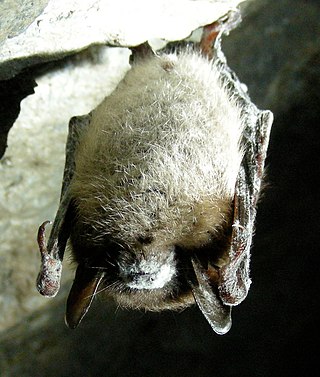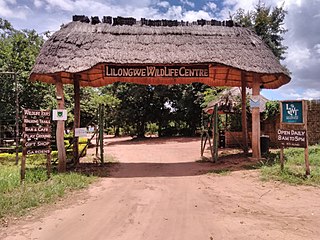The Monkey Sanctuary was founded in 1964 by Len Williams, father of classical guitarist John Williams, as a cooperative to care for rescued woolly monkeys. Based in Looe, Cornwall, England, the sanctuary is home to woolly monkeys that are descended from the original rescued pets, a growing number of capuchin monkeys rescued from the current UK pet trade, and a small group of rescued Barbary macaques. The monkeys live in large enclosures that the general public can view during the Sanctuary's open season in the summer months.

Connecticut's Beardsley Zoo, located in Bridgeport, Connecticut, is the only AZA-accredited zoo in the state of Connecticut. It includes one of the few carousels in the state.

The Mexican free-tailed bat or Brazilian free-tailed bat is a medium-sized bat native to the Americas, so named because its tail can be almost half its total length and is not attached to its uropatagium. It has been claimed to have the fastest horizontal speed of any animal, reaching top ground speeds over 99 mph (160 km/h). It also flies the highest among bats, at altitudes around 3,300 m (10,800 ft).

The big brown bat is a species of vesper bat distributed widely throughout North America, the Caribbean, and the northern portion of South America. It was first described as a species in 1796. Compared to other microbats, the big brown bat is relatively large, weighing 15–26 g (0.53–0.92 oz) and possessing a wingspan of 32.5–35 cm (12.8–13.8 in).

The white-winged vampire bat, a species of vampire bat, is the only member of the genus Diaemus. They are found from Mexico to northern Argentina and are present on the islands of Trinidad and Margarita.

The Alaska SeaLife Center, Alaska's premier public aquarium and Alaska's only permanent marine mammal rehabilitation facility, is located on the shores of Resurrection Bay in Seward in the U.S. state of Alaska. Open since May 1998, it is dedicated to understanding and maintaining the integrity of the marine ecosystem of Alaska through research, rehabilitation, conservation, and public education. It is the only facility in the world specifically dedicated to studying the northern marine environment and the only one designed at the outset to combine research with public education and visitor components. The Alaska SeaLife Center generates and shares scientific knowledge to promote understanding and stewardship of Alaska's marine ecosystems.

Bracken Cave is the summer home to the largest colony of bats in the world. An estimated 20 million Mexican free-tailed bats roost in the cave from March to October making it the largest known concentration of mammals. The cave is located in southern Comal County, Texas, outside the city of San Antonio. The 100-foot (30 m)-wide crescent shaped opening to the cave lies at the bottom of a sinkhole, formed when the roof of the cave collapsed.

Wildlife rehabilitation is the treatment and care of injured, orphaned, or sick wild animals so that they can be released back to the wild.

Earthplace is a non-profit science education organization, in Westport, Connecticut in the United States. Its main focus is on the natural world and sustainability.

The Ann W. Richards Congress Avenue Bridge crosses over Lady Bird Lake in Austin, Texas. Before construction of the Longhorn Dam was completed in 1960, the bridge crossed the Colorado River from which Lady Bird Lake is impounded. The bridge was known as the Congress Avenue Bridge from the construction of the first span across the Colorado River at that location in the late 19th century until November 16, 2006, when the Austin City Council renamed the current bridge in honor of Ann W. Richards, the 45th Governor of Texas and a long-term resident of Austin. The bridge is a concrete arch bridge with three southbound and three northbound vehicle lanes and sidewalks on both sides of the bridge.

The Fijian mastiff bat, also known as the Fijian free-tailed bat, is a species of bat in the family Molossidae. It is found in Fiji and Vanuatu. In 2013, Bat Conservation International listed this species as one of the 35 species of its worldwide priority list of conservation. This species is currently listed as endangered and considered a species of special concern due to habitat fragmentation and cave disturbance. The Fijian free-tailed bat is endemic to Fiji and Vanuatu islands. This species was previously documented on the islands of Taveuni and Vanua Levu, current research indicates possible small fragmented populations inhabiting both islands. Only two insectivorous bats occupy Fiji, the Pacific sheath-tailed bat and the Fijian free-tailed bat. Both species consume night flying insects, foraging high above the canopy.

White-nose syndrome (WNS) is a fungal disease in North American bats which has resulted in the dramatic decrease of the bat population in the United States and Canada, reportedly killing millions as of 2018. The condition is named for a distinctive fungal growth around the muzzles and on the wings of hibernating bats. It was first identified from a February 2006 photo taken in a cave located in Schoharie County, New York. The syndrome has rapidly spread since then. In early 2018, it was identified in 33 U.S. states and seven Canadian provinces; plus the fungus, albeit sans syndrome, had been found in three additional states. Most cases are in the eastern half of both countries, but in March 2016, it was confirmed in a little brown bat in Washington state. In 2019, evidence of the fungus was detected in California for the first time, although no affected bats were found.

The Borneo Orangutan Survival (BOS) Foundation is an Indonesian non-profit non-governmental organization founded by Dr. Willie Smits in 1991 and dedicated to the conservation of the endangered Bornean orangutan and its habitat through the involvement of local people. It is audited by an external auditor company and operates under the formal agreement with the Indonesian Ministry of Forestry to conserve and rehabilitate orangutans. The BOS Foundation manages orangutan rescue, rehabilitation and re-introduction programmes in East and Central Kalimantan. With more than 400 orangutans in its care and employing more than 440 people at a 10 sites BOS Foundation is the biggest non-human primate conservation non-governmental organization worldwide. Nyaru Menteng and Samboja Lestari are the BOS Foundation sites that have received most extensive media coverage. Nyaru Menteng, founded by Lone Drøscher Nielsen, has been the subject of a number of TV series, including Orangutan Diary, Orangutan Island and the series Orangutan Jungle School, airing since 2018.
The Great Lakes Bat Festival is an annual two-day summer event that started in 2002.1 It has been held at the Cranbrook Institute of Science Bat Zone in Bloomfield Hills, Michigan2, at the Indiana State University Center for North American Bat Research and Conservation in Terre Haute, Indiana3, at the Milwaukee County Zoo in Milwaukee, Wisconsin, and in Iron Mountain, Michigan near Millie Hill Mine4.

Organization for Bat Conservation (OBC) was a national environmental education nonprofit based in Bloomfield Hills, Michigan, established to educate and inspire people to save bats. In February 2018, it was announced that the Organization was ceasing operations due to unexpected financial problems and personnel changes.
Monfort Bat Sanctuary has been the house of a large colony of 2.3 million Rousette fruit bats since recorded history. They cover 75% of the ceilings and walls of their 245 ft (75 m)-long cave The sanctuary is located on Samal Island, about 1 kilometre (0.62 mi) east of Davao City, Philippines. According to Guinness World Records, it is the largest single colony of this kind.

The Lilongwe Wildlife Centre is a wildlife sanctuary in Lilongwe, Malawi. It was founded in 2007 by the Lilongwe Wildlife Trust (LWT), with support from the Born Free Foundation. The Centre is a member of the Pan African Sanctuary Alliance.
The Pan African Sanctuary Alliance (PASA) is an association of wildlife centers in Africa, founded in 2000 in Uganda. The activities of PASA includes rescuing and caring for orphaned apes and monkeys, promoting the conservation of wild primates, educating the public, empowering communities, and working to stop the illegal trade in wildlife.














